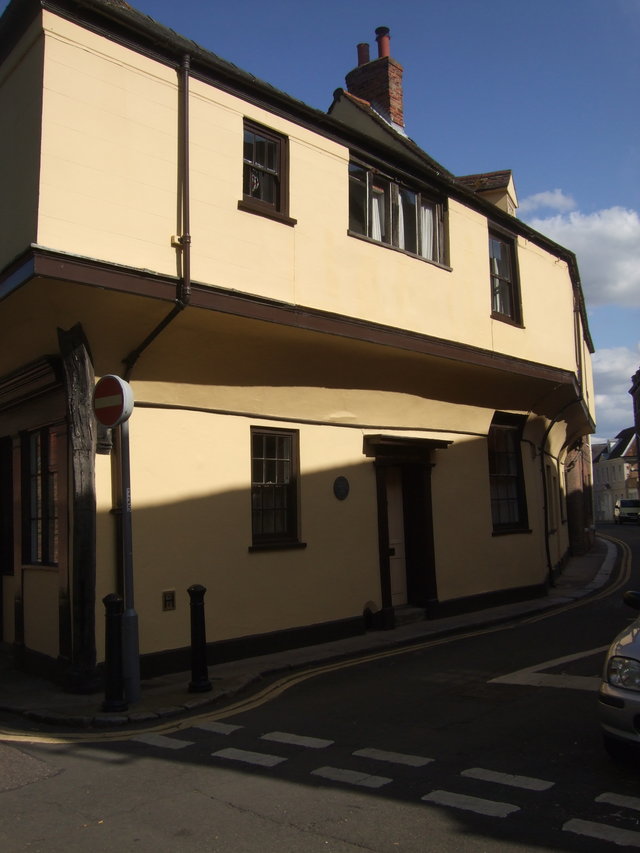» Main Index

» Search This Site

» Submit Update

» Contact Us


|
|

|
Home > Norfolk >
Kings Lynn > Valiant Sailor
Valiant Sailor
 |
|
Date of photo: 2014 |
Picture source: Admin |
|
|
|
|
The Valiant Sailor was situated
at 2
Nelson Street. This 15th century building became an inn in the late 17th
century. It lost its licence in 1925. The famous artist, Edward Dexter,
lived here until his death in 1958. |
|
|
|
A grade-II* listed
house, previously The Valiant Sailor public house, standing on the site of
Priory buildings that where cleared in the Reformation 1540-50. Nelson
Street was previously known as Lath(e) Street. The Valiant Sailor reportedly
takes its name from the actions of Jack Crawford during the Battle of
Camperdown against the Dutch in 1797 but I find no evidence of another name
prior to this. Possibly an inn from the late 1600s the first recorded
licensee is William Wood from at least 1735 to 1764 but the inn appears in
the 1728 Sessions Minutes. The building was offered for sale by the
Ecclesiastical Commissioners from about 1869. Leased by Richard Bagge
1848-1885 it was purchased by Thomas Edward Bagge in 1885. It was referred
for Compensation 04.02.1924 and the licence was extinct 21.01.1925. The
Council plaque informs us that 'Walter Dexter Artist lived here 1953-1958'. |
|
Steve Turner (November 2021) |
|
|
|
|
|
|
Listed
building details: |
Formerly known as: Nos.2 and 4 The
Valiant Sailor (2) (Public House) Nelson Street. Shop and house, formerly a
public house, now wholly domestic Constructed on the site of buildings
relating to St Margaret's Priory, cleared at the Reformation. 1540-50.
Timber-framed with brick. Rendered and colourwashed. Plain tiled roof to
south, slate to north, the division marking a change in roof heights.
2 storeys and dormer attic on a curved site. Panelled door to right with an
overlight leads into No 4. Two further doors to west elevation and sashes
with glazing bars at intervals. Deep coved jetty is plastered. At north-west
corner is an exposed moulded dragon post, with, behind it, a C16 timber
panel with carved figures, possibly representing the Annunciation. Jetty
continues into north return above the former public house facade: 5 pilaster
strips containing a sealed doorway and casements. First-floor fenestration
of sashes with glazing bars and, towards north end, one 4-light
diamond-mullioned timber window with a King mullion. Gabled roof to south,
hipped to north. 2 gabled dormers in south roof. Ridge stack at division of
roofs. C20 stack on line of east (rear) wall at north end. The rear with
whitewashed brick to ground floor, heavy scantling timber studs to first
floor. Arched braces and brick nogging. Various casements and sashes.
Interior. Ground floor main room (to north and west) with 2 massive plain
bridging beams running north-south, obliquely scarf-jointed. Square dragon
beam to north-west corner. West wall retains 3 blocked openings to shop
arcade formed by inserting knuckle braces between principal studs and middle
rail. Above middle rail secondary studs define additional panels. Arcade
openings with jambs rebated for shutters. Over outer 2 arcade openings the
upper panels are also rebated for shutters. To right of arcade 2 hinge posts
survive for a former door. This arcade said to have extended to south end of
facade, as is likely. The first floor is rich with widely-spaced studs. Roof
over north part of house as far south as the ridge stack is all replaced.
Roof to south end rebuilt on an outer and
higher line, explaining the differing heights seen from the exterior. Some
principal rafters of original structure survive, but rebuilding and re-use
of extraneous timbers prevent a coherent identification of roof-type. |
|
|
|
Do you have any anecdotes, historical information, updates or photos of this pub? Become a contributor by submitting them here. Like this site? Follow us on

You can also make email contact with other ex-customers and landlords of this pub by adding your details to this page. |
|
|
|
Other Photos |
 |
|
Date of photo: 2014 |
Picture source: Admin |
|
|